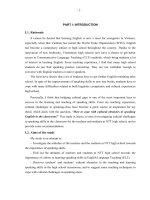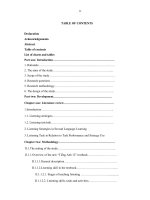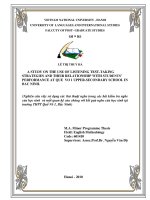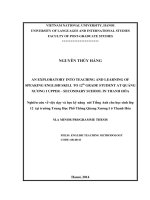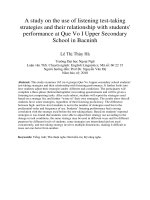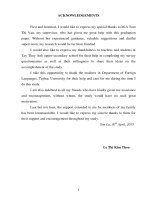an exploratory into teaching and learning of speaking English skill to 12th grade students at Quang Xuong I Upper – Secondary school in Thanh Hoa = Nghiên cứu v
Bạn đang xem bản rút gọn của tài liệu. Xem và tải ngay bản đầy đủ của tài liệu tại đây (633.75 KB, 67 trang )
VIETNAM NATIONAL UNIVERSITY, HANOI
UNIVERSITY OF LANGUAGES AND INTERNATIONAL STUDIES
FACULTY OF POST-GRADUATE STUDIES
*********************
NGUYỄN THÚY HẰNG
AN EXPLORATORY INTO TEACHING AND LEARNING OF
SPEAKING ENGLISH SKILL TO 12th GRADE STUDENT AT QUẢNG
XƢƠNG I UPPER – SECONDARY SCHOOL IN THANH HÓA
Nghiên cứu về việc dạy và học kỹ năng nói Tiếng Anh cho học sinh lớp
12 tại trƣờng Trung Học Phổ Thông Qủang Xƣơng I ở Thanh Hóa
M.A MINOR PROGRAMME THESIS
FIELD: ENGLISH TEACHING METHODOLOGY
CODE: 60140111
Hanoi, 2014
VIETNAM NATIONAL UNIVERSITY, HANOI
UNIVERSITY OF LANGUAGES AND INTERNATIONAL STUDIES
FACULTY OF POST-GRADUATE STUDIES
*********************
NGUYỄN THÚY HẰNG
AN EXPLORATORY INTO TEACHING AND LEARNING OF
SPEAKING ENGLISH SKILL TO 12th GRADE STUDENT AT QUẢNG
XƢƠNG I UPPER – SECONDARY SCHOOL IN THANH HÓA
Nghiên cứu về việc dạy và học kỹ năng nói Tiếng Anh cho học sinh lớp
12 tại trƣờng Trung Học Phổ Thông Qủang Xƣơng I ở Thanh Hóa
M.A MINOR PROGRAMME THESIS
FIELD: ENGLISH TEACHING METHODOLOGY
CODE: 60140111
SUPERVISOR: Dr. LÊ VĂN CANH
Hanoi, 2014
DECLARATION
I certify that the thesis entitled “An exploratory into teaching and
learning of speaking English skill to 12th grade students at Quang Xuong I
Upper – Secondary school in Thanh Hoa” and submitted in partial
fulfillment of the requirements for the degree of Master of Arts is the result of
my work, except where otherwise acknowledged, and that this minor thesis or
any part of the same has not been submitted for a higher degree to any other
university or institution.
Hanoi, September 2014
Signature
Nguyễn Thúy Hằng
i
ACKNOWLEDGMENTS
First of all, I would like to acknowledge and express my deep gratitude
to my supervisor, Dr Le Van Canh, for his enlightening lectures in the
Methodology and Materials Development Courses, greatly enthusiastic
guidance, encouragement, and constructive comments in-depth along the way
with my project. Without his support, this thesis would not be able to be
completed properly.
My sincere thanks go to all the lecturers of the Faculty of Post Graduate
Studies, Hanoi University of Languages and International Studies, Vietnam
National University, whose instructions have laid foundation for my work. I
would also like to express my special thanks to all the staff for their constant
assistance while my work was in process.
My thanks also go to my colleagues and students at Quảng Xương 1
Upper- Secondary School in Thanh Hoa province for their cooperation and
help in classroom observation, interviews, and their willingness to share their
ideas on teaching and learning English.
Finally, I wish to thank all my friends and colleagues for their support
during my completion of this study.
Hanoi, September 2014
ii
ABSTRACT
In English classess in non- gifted upper- secondary school the teaching
and learning English speaking skill is considered as unimportant as the
students‟ aim is to pass the General Certificate Education exam. The research,
which explored the teaching and learning of speaking skill to grade 12
students at Qủang Xương I Upper – Secondary school, aimed to have better
understanding of this reality.
The subject of the study was 144 students from three different classes and
three teachers teaching in 12 graders at Qủang Xương I Upper – Secondary
school in Thanh Hoa. Three lessons were observed, four students and three
teachers were interviewed. The data collected from class observations and the
interviews were transcribed and analyzed.
The picture of reality of the teaching and learning speaking at the school
included the procedure of the speaking
lessons, classroom interaction
patterns the task types and the effectiveness of the teaching speaking at Quảng
Xương 1 Upper- Secondary School. The results of the study revealed that the
teaching and learning of speaking at Quang Xuong 1 school were not
satisfactory. Two recommendations on how to improve this situation were
made to both teachers and students at the school.
iii
ABBREVIATIONS
1. WTO
World Trade Organization
2. CLT
Communicative Language Teaching
3.GCSE
General Certificate of Secondary Education
4.WWF
World Wild Fund
5. WHO
Worl Health Organization
6. IRE
Initiative Response Evaluation
7. UNICEF United Nation International Children‟s Emergency Fund
8. TEFL
Teaching English as second language
iv
TABLE OF CONTENTS
DECLARATION ....................................................................................................... i
ACKNOWLEDGMENTS ........................................................................................ii
ABSTRACT ............................................................................................................. iii
ABBREVIATIONS .................................................................................................. iv
TABLE OF CONTENTS .......................................................................................... v
PART A: INTRODUCTION.......................................................................... 1
1.Statement and problem ............................................................................... 1
2. Aims and objectives of the study ............................................................... 1
3. Research questions ...................................................................................... 1
4. Methods of the study ................................................................................... 2
6. Organization of the thesis ........................................................................... 2
PART B: DEVELOPMENT ......................................................................... 4
CHAPTER 1: LITERATURE REVIEW...................................................... 4
1.1. Theoretical background of speaking in second language teaching and
learning............................................................................................................. 4
1.1.1.
Definitions of speaking ...................................................................... 4
1.2. Role of speaking in second language acquisition .................................. 4
1.2.1.The input and output hypothesis .......................................................... 4
1.2.2. The interaction hypothesis ................................................................... 5
1.3. Approaches to the teaching of speaking skill. ...................................... 5
1.4. Approaches to the learning of speaking skill....................................... 9
1.5. Input, feedback, and output in foreign language learning................. 11
1.6. Speaking tasks ........................................................................................ 11
v
1.7. Classroom Interactions .......................................................................... 12
1.7.1. Participants in classroom interraction .............................................. 13
CHAPTER 2: THE STUDY ......................................................................... 17
2.1. Research setting...................................................................................... 17
2.1.1. An overview of the researched school. ............................................. 17
2.2. Research approach ................................................................................. 18
2.3. Research method .................................................................................... 18
2.3.1. Data collection method ....................................................................... 18
2.3.2.Classroom observation ........................................................................ 18
2.3.3. Post observation Interviews ............................................................... 19
2.4. Data analysis method ............................................................................. 19
2.5. Procedure of the study ........................................................................... 20
CHAPTER 3: FINDINGS ANALYSIS AND DISCUSSION.................... 21
3.1. Procedure of speaking lessons at Quảng Xƣơng 1 Upper-Secondary
School.............................................................................................................. 21
3.2. Classroom interaction patterns in the speaking lessons ..................... 23
3.3.Common task types used by the teachers in speaking lessons ............ 25
3.4. The effectiveness of the teaching of speaking at Quảng Xƣơng 1
Upper- Secondary School ............................................................................. 27
PART C: CONCLUSION ............................................................................ 29
1. Summary of major findings ..................................................................... 29
2. Concluding remarks ................................................................................. 30
3. Reflections .................................................................................................. 31
3. 1. Hesitance or unconfidence of students ................................................ 31
vi
3.2. Lack of vocabularies, structures ........................................................... 31
3.3. Lack of language environment ............................................................. 32
3.4. Difficulties from the teachers ................................................................ 32
3.5. Other difficulties..................................................................................... 32
3.5.1. Classroom size ..................................................................................... 32
3.5.2. Time constraint ................................................................................... 32
3.5.3. Lack of reference materials................................................................ 33
3.5.4. Lack of facilities .................................................................................. 33
3.5.5. Poor background knowledge ........................................................... 33
3.5.6. Bad group work controls. ................................................................. 33
3.6. Suggestions for support for teachers .................................................... 34
3.6.1. Motivate students to participate in the speaking skills lessons ...... 34
3.6.2. Vary the teaching techniques ............................................................ 34
3.6.3.Create a warm class atmosphere ........................................................ 35
3.6.4. Redesign the task for some topics ..................................................... 35
3.6.5.Options of correcting errors for students in speaking lesson. ......... 35
3.6.6. Overcome time constraint problem .................................................. 35
3.6.7. Provide teaching facilities................................................................... 36
3.6.8. Help students to be confident ............................................................. 36
3.6.9. Create opportunities for students to use English in real life .......... 36
3.7. The teacher’s self-improvement of speaking skill ............................... 36
3.8. Monitor group work activities .............................................................. 37
4. Limitations of the study ............................................................................ 37
vii
5. Suggestions for further research ............................................................. 38
REFFERENCES ........................................................................................... 39
APPENDIX 1 .................................................................................................... I
viii
PART A: INTRODUCTION
1.Statement and problem
Students‟ ability to speak English is one of the main goals of any English
language teaching program from the perspective of communicative language
teaching. Without the ability to speak the language, students cannot learn the
language successfully. However, students seem to be weak at speaking, and this is
true in the context of secondary schools in Vietnam where the teaching of speaking
is not given enough attention. This is because speaking is not tested, and teachers
claim that when speaking is not tested, students are not interested in learning to
speak English.
As a secondary school teacher, I think it is necessary to explore the reality of
teaching and learning speaking English in an attempt to identify the reasons why
students are not interested in learning to speak English. This issue is very important
but not many people have ever researched it. This study was conducted in one
secondary school in Thanh Hoa Province to serve this purpose.
2. Aims and objectives of the study
Overall, the research aims at exploring the reality of classroom teaching and
learning speaking English at a secondary school in Thanh Hoa pronvince. The
following objectives are set out for the study:
- To gain understanding of how speaking lessons were conducted in the
classroom at the researched school.
- To explore the common interaction patterns in the English-speaking lessons
in the school.
3. Research questions
In order to achieve the above aims and objectives, the following research
questions were formulated:
1. How are speaking lessons conducted in Quảng Xương 1 Upper – Secondary
school?
2. What are the common interaction patterns in the speaking lesson?
1
3. What task types do teachers commonly use in the speaking lesson?
4. To what extent does teachers‟ teaching speaking helps students to develop
their speaking skills as reflected in their performance of classroom speaking tasks?
4. Methods of the study
In order to achieve the aims of the study , an exploratory approach is used.
The data was collected by means of classroom observations and interviews. The
purpose of classroom observations were to gain the understanding of how the
teachers taught and how the students learnt in the English-speaking lessons. All the
observed lessons were video-recorded and fully transcribed for analysis. The postobservation interviews were conducted in an attempt to obtain additional
information, which aids the understanding of what was unobservable in the
classroom, i.e. teachers‟s reasoning of their teaching behaviours.
5. Scope of the study
The study is concerned with how English speaking lessons were taught and
learned involved 3 teachers and 144 students in one secondary school. Its focus is
on common classroom interaction patterns and the influence of these interactional
patterns on students‟ learning to speak English.
6. Organization of the thesis
The paper is developed into main three parts: the Introduction, the
Development and the Conclusion
Part A is Introduction. the background to the study, states the aims, significance,
discusses the scope of the study, method and procedure and outlines the thesis.
.Part B is Development
Chapter 1. . Literature review presents the issues relating to speaking, the role of
speaking in second language acquisition, approaches to the teaching of speaking skill,,
approaches to the learning of speaking skill, input,feedback and output in foreign language
learning, speaking tasks, classroom interaction.
Chapter 2: The study presents
research ,
method.
2
research approach, research
Chapter 3: Findings analysis and discussion and discussion, presents the
results from the classroom observation and interview. The chapter ends with a
discussion of the findings.
Part C: Conclusion
1. Summary of major findings
2.. Concluding remarks
3.. Reflections
4. . Limitations of the study
5. Suggestions for further research
3
PART B: DEVELOPMENT
CHAPTER 1: LITERATURE REVIEW
1.1. Theoretical background of speaking in second language teaching and
learning.
1.1.1. Definitions of speaking
Speaking is "the process of building and sharing meaning through the use of
verbal and non-verbal symbols, in a variety of contexts"(Chaney,1998, p.13).
Speaking is a crucial part of second language learning and teaching. Florez (1991:1)
defines speaking as “an interactive process of constructing meaning that involves
producing and receiving and processing information” (cited in Bailey, 2005:2).
From the above definitions, it can be concluded that speaking is the
productive aural/ oral skill. It consists of producing systematic verbal utterances to
convey meaning.
1.2. Role of speaking in second language acquisition
1.2.1.The input and output hypothesis
Krashen‟s (1985) Comprehensible Input Hypothesis claims that language
input (listening and reading) is important in the language program and that fluency
in speaking or writing in a second language will naturally happen after learners have
built up sufficient competence through comprehending input. Many studies on the
nature of input revealed that input facilitates the acquisition of words in the target
language, but does not aid the acquisition of certain syntactic structures (Ellis,
1994).
Swain (1985) argues that comprehensible input is necessary but not
sufficient in promoting second language acquisition. She proposed the
Comprehensible Output Hypothesis, according to which learners need be triggered
to produced intended meaning. Swain points out that while trying to produce the
intended meaning (speaking) learners may notice the gap in their interlanguage
knowledge in an attempt to produce the target language to prompt them to solve
their linguistic deficiency in ways that are appropriate in a given context.
4
1.2.2. The interaction hypothesis
Long‟s Interaction Hypothesis (1996) posits that interaction focuses on the
„negotiation for meaning‟. The frequency of occurrence of the target form brings
about salience, negative feedback, and input modifications to increase
comprehensibility and content predictability. These processes induce „noticing‟ of
new forms, new form-meaning connections, gaps in interlanguage, and mismatch
between input and output. Long (1996) noted that interaction facilitates
comprehension and acquisition of semantically contingent speech and negotiation
for meaning. Long stresses the importance of the interactional modifications that
occur in negotiating meaning. In other words, interactive input is more important
than non-interactive input (Ellis, 1994).
Classroom interactional tasks that stimulate negotiation for meaning may
turn out to be those among several useful language-learning activities, for they may
be the easiest ways to facilitate a learner‟s focus on form. Classroom interactional
tasks often contain learner classroom participation,group work, teacher talk, role
plays, etc.The communicative language teaching theory reveals that communication
and interaction are the purpose of language learning (Richards & Rodgers, 1986),
and previous studies on communicative language teaching (Hymes, 1972; Nunan,
1991) show that interaction facilitates the learning of language functions as well as
of target language forms.
1.3. Approaches to the teaching of speaking skill.
1.3.1. Communicative Language Teaching (CLT)
Communicative language teaching (CLT) refers to both processes and goals
in classroom learning. The central theoretical concept in communicative language
teaching is „„communicative competence,‟‟ a term introduced into discussions of
language use and second or foreign language learning in the early 1970s Habermas
1970; Hymes 1971; Jakobovits 1970; Savignon 1971).
CLT puts the focus on the learner. Learners‟ communicative needs provide a
framework for elaborating program goals with regard to functional competence.
5
Functional goals imply global, qualitative evaluation of learner achievement as
opposed to quantitative assessment of discrete linguistic features. At the same time,
Brumfit and Johnson (1979) emphasized “the functional and communicative
potential of language. They saw the need to focus on communicative proficiency
rather than on mere mastery of structures” (Richards and Rodgers, 2001:153). CLT
features more interaction- based activities such as role plays, information gaps, pair
work and group work. In summary, among some approaches of the language
teaching methods, CLT is the most appropriate way for communication.
Features of CLT
The fundamental principle of CLT is to enable learners to understand and use
the target language for communication. Two basic assumptions underlying this
approach to language learning are that the core of language learning is the
development of communicative competence and that the starting point for language
learning is not grammatical rules but context, function, meaning and the appropriate
use of the language.
Richards and Rogers identify the distinct characteristics of communicative language
teaching as (1986: P.71):
„Language is a system for the expression of meaning. The primary function
of language is for interaction and communication function of language. The
structure of language reflects its functional and communicative uses. The primary
units of language are not merely its grammatical and structural features, but
categories of functional and communicative meaning as exemplified in discourse.’
This approach calls for radically different ideas of language teaching. One
major shift is that language learning has become student-centred. Lessons are
planned in such a way that all the students can engage in interactive activities.
Authentic and meaningful communication should be goal of classroom act
ivies. Group work and pair work are employed to promote communication and
getting the meaning across. Authentic materials, such as newspaper articles, radio
programmes, video-tapes, train-timetables etc., are used to bring the real world
6
elements into the classroom. Situations are simulated but interaction and task
complete within real-time are genuine. Role-plays centre on communicative
functions.
Fluency is an important dimension of communication. The objective of
language learning is to communicate; attempts to communicate are encouraged at
the very beginning. Errors are unavoidable but accuracy is judged in context rather
in structures and forms. Errors which are concerned with structures are not
corrected openly and simultaneously because the main concern is fluency and
getting meaning through communication. Learning is a process of creative
construction and involves errors.
In brief, CLT is characterized with communicative competence, leaner‟s –
centeredness and four skills integration. These characteristics will be the principles
for teachers to choose appropriate techniques as well as activities in the classroom
to improve students‟ communicative competence.
In fact, for each method, we are positive in teaching speaking by using
different way.Language teachers have to be able to provide students with a better
and more complete picture of what foreign language learning is about. While
teaching we have to change how to teach dramatically because the boring and
mechanical types of structural drills have virtually been replaced by a variety of
engaging activities.
Breen & Candlin (1980) described CLT teacher as a facilitator; an
interdependent participant and a researcher and learner Medgyes wrote (1986:
P.107): „The communicative classroom requires a teacher of extraordinary abilities:
a multi-dimensional, high-tech, Wizard-of Oz like supper person - yet of flesh and
blood. In a CLT classroom, teachers keep a low profile in their functions, relax their
control of the class, resort to gentle correction, organise activities and stand aside,
prompt with discretion and offer help only when requested. However, this
withdrawal should not mean relinquishing control over the class, and it requires the
7
teacher an extremely high degree of professional sophistication. They need very
much more energy and adaptability ( Nunan: 1987).
The teacher was only provider of knowledge, the model for correct forms,
and the controller of the class. The textbooks contained sets of lessons to be learnt,
and all classroom interaction was teacher and textbook dominated. Lessons tended
to look similar to each other. Nevertheless, this goal has been set – to develop the
learner‟s communicative competence. Learners want to be able to use the foreign
language for personal need fulfilment. Teachers must change not only in the extra
skills required, but in the teacher‟s whole attitude to language, language learning
and the role of the teacher.
In the light of the CLT approach which takes the learners‟ communicative
competence as the final goal, a T.E.F.L class is considered to be successful if the
learners speak English as much as they can and the teacher speaks it as little as
possible. Larsen-Freeman (1986:132) states that “activities in the Communicative
Approach are often carried out by students in small groups”. CLT favors interaction
among small numbers of students in order to maximize the time allotted to each
student for learning to negotiate meaning.
Clearly, cooperative learning is stressed in CLT. In the book “A Course in
TEFL”, Nguyen Bang and Nguyen Ba Ngoc list cooperative learning as one feature
that CLT bears. A classroom that is cooperative and therefore not competitive –
usually involves the above learner-centered characteristics. As students work
together in pairs and groups, they share information and come to each other‟s aid.
They are a “team” whose players must work together in order to achieve goals
successfully.
These characteristics will be the principles for teachers to choose appropriate
techniques as well as activities in class to improve the students‟ communicative
competence. All learning activities should be selected according to how well they
engage the students in meaningful and authentic language use rather than only
mechanical practice of language patterns to achieve accuracy in language forms.
8
1.3.2. The Grammar – Translation Method
Grammar- translation method is one of the most traditional methods. It
was originally used to teach “dead” languages (and literature) as Latin and
Greek, involving little or no spoken communication or listening
comprehension.
The principle of this method requires students to translate the whole
texts word by word and memorize numerous grammartical rules and
exceptions as well as enormous vocabularies list. The teacher‟s role is to be
authority in the classroom. The students‟role is to do what the teachers say. Most
of the interaction is from the teacher to the students.
1.3.3. Audio – lingualism
In this method, speaking skills are taught by having students repeat sentences
and memorized textbook dialogues. Repeatition drills are a hallmark of audilingual
method, and are designed to familiarize students with the sound and structural
patterns of the taught language. A theory of behind the audio lingual method is
behaviourism which views learning as a process of habit formation through the
stimulus-response processes. Under this method, “teaching oral language was
thought to require no more than engineering the repeated oral production of
structure…” ( Bygate, 2001,p.15)
1.4. Approaches to the learning of speaking skill
As stated in article “ Better English, better speaking skills” retrieved from
,1 English language learners are often anxious to
learn the speaking skill quickly. They define fluency as the ability to converse
confidently with others, and regard speaking as the most important skill they can
acquire and they asses their progress in terms of their accomplishments in spoken
communication.
9
Students need to realize that speaking skill is progressively learnt by going
through three areas knowledge:
∙ Learning the mechanics: Grammar, vocabulary, and pronunciation, the use of
correct words in the right order with the correct pronunciation.
∙ Functional use: Using the language to transact messages - the exchange of
information- with clarity and to interact with understanding.
∙ Social and cultural rules and norms: like taking turns to speak, the rate of
speaking, the length of pauses between speakers and relative roles of participants.
Understanding the message (verbal and non-verbal), the circumstances, the reason
and what the person is communicating.
Students need an environment to practice authentic English that is used in real-life
communication situations. The English Club lesson periods are within Master
English curriculum to afford the opportunity for students to learn and practice
speaking real English.
Goh and Burns (2012) after considering current practices in conducting speaking
lessons, conclude,
“Although
speaking activities occur frequently in their classrooms,
learners seldom have the opportunity to learn the skills and strategies and the
language to improve their speaking. While learners do a lot of talking in class
activities, there is often insufficient teaching of speaking as a language
communication skill.” (p. 2)
These authors point out that although the students in speaking lessons may
manage to complete each activity given by the teacher by drawing on their existing
language and cognitive resources, they do not learn anything new that they would
do without the teacher‟s help. In addition, in many speaking lessons, students seem
to be very passive. Although they participate in speaking activities, they are not
encouraged to self-regulate their learning by planning, monitoring, and evaluating
their own performances.
10
1.5. Input, feedback, and output in foreign language learning
Hatch (1978) emphasizes the important role that speaking plays in
second/foreign language learning. Hatch and other scholars argue that by engaging
in talk with more competent speakers, language learners will derive two key
benefits. First, they will be helped by their interlocutors‟ input and feedback.
Besides being exposed to the input in interaction, learners also have a chance to
hear a more accurate model of language being used. Although comprehensible input
is necessary, it is not sufficient. Language learners also need opportunities to
produce comprehensible output (Swain, 1985). Besides language input, learners
also need feedback in the form of questions, comments, repetitions, confirmation
checks, requests for clarification, and reformulations (Goh & Burns, 2012).
The importance of input-feedback-output in oral interaction with competent
speakers has led to the development of various hypotheses about the role of
feedback in second language learning (Gass, 1997). Goh and Burns (2012)
comment that ideally speaking activities should allow teachers to provide input and
feedback to every language learner and to “push” each one to produce well-formed
utterances. However, they argue that in reality it is not possible for most teachers to
do so because of physical constraints such as large class size. They advise teachers
to plan activities that draw their students‟ attention to linguistic forms, discourse
structure, and vocabulary that can further develop the learners‟ ability to speak
accurately. Explicit instruction on language forms has been shown to contribute to
learners‟ oral language development (Sheen, 2005).
1.6. Speaking tasks
Broadly categorized, there are two main speaking task types in terms of purposes:
interpersonal tasks and interactional tasks. Interpersonal tasks are aimed at
establishing and maintaining social relationship while transactional tasks are aimed
at getting things done. Thus, speaking tasks are designed to provide learners with
opportunities to practice their speaking so that they can achieve greater fluency.
11
Goh and Burns (2012) list three different speaking tasks that can be used in the
classroom. These are communication-gap tasks, discussion tasks, and monologic
tasks.
In communication-gap tasks, participants in interaction do not share the same
information or background knowledge. This creates the gap which encourages
speakers to continue the interaction. In information-gap tasks, learners are given
different sets of information for a task. They need to work together tin pairs or small
groups to share the information in order to achieve a pre-defined goal. For contextgap tasks, learners in both pairs or groups are given the same set of information,
such as a set of pictures and a list of words. They have to use the information to
construct new content for their listeners. These tasks are called context-gap tasks
because they allow individual learners to create a context for the information that
they are sharing, encouraging them to express their meaning by drawing on their
knowledge of the language (see Goh & Burns, 2012: 202-204).
1.7. Classroom Interactions
The Cambridge International Dictionary of English defines the verb „to
interact‟ as „to communicate with or react to (each other)‟. The New Oxford
Dictionary of English defines the noun „interaction‟ as a „reciprocal action or
influence‟ Therefore interaction is more than action followed by reaction. It
includes acting reciprocally, acting upon each other. Rivers (1987, 57) describes the
word through its Latin roots: „agere‟ meaning „to do‟ and „inter‟ meaning „among‟.
It shows us the active and social part of a human being that affects other people
through interaction. Brown (2001, 165) relates interaction to communication,
saying, “…interaction is, in fact, the heart of communication: it is what
communication is all about”. Interaction has a similar meaning in the classroom.
We might define classroom interaction as a two-way process between the
participants in the learning process: the teacher influences the learners and
vice versa.
Teacher
-
Student
12
1.7.1. Participants in classroom interraction
These are the most frequent ways of organising classroom interaction,
depending on who communicates with whom:
a) Teacher – learners
b) Teacher – learner/a group of learners
c) Learner – learner
d) Learners – learners
The first form of interaction (teacher – learners) is established when a
teacher talks to the whole class at the same time. He takes the role of a leader or
controller and decides about the type and process of the activity. The primary
function of such interaction is controlled practising of certain language structures or
vocabulary. Mostly, they are in the form of repeating structures after the teacher
(the model). This type of practice is also referred to as „a drill‟. The second
arrangement is conducted when the teacher refers to the whole class, but expects
only one student or a group of students to answer. It is often used for evaluation of
individual students. This arrangement can also be used for an informal conversation
at the beginning of the lesson or for leading students into a less guided activity.
The third type of interaction is called „pair work‟. Students get an assignment,
which they have to finish in pairs. The teacher holds the role of a consultant or adviser,
helping when necessary. After the activity, he puts the pairs into a whole group and each
pair reports on their work. te last type of classroom interaction is called „group work‟. As
with pair work, the teacher‟s function here is that of a consultant and individual groups
report on their work as a follow-up activity.
The last two ways of organisation are particularly useful for encouraging
interaction among students. In large classes, they present the only possibility for as
many students as possible to use the foreign language. The research has shown
(Long et al. 1976 in Nunan 1991, 51) that students use more language functions in
pair- and group-work than in other forms of interaction. It has also been proven that
13
students perceive them as the most pleasant ways of learning, because they feel
relaxed and subsequently communicate better (Phillips 1983 in Hatch 1992, 93).
Such work encourages independent learning and gives some responsibility for
learning to students. It approaches real-life communication where students talk to
their peers in small groups or pairs. Nevertheless, whole-class organisation should
not be completely neglected since it is still more appropriate for guided and
controlled activities. In a traditional classroom the teacher had the dominant role of
an all-knowing leader who „filled‟ students‟ empty heads with knowledge. This role
has changed and the teacher has now got many roles depending on diff erent
classroom situations. In a broad sense, he is a „facilitator of learning‟, which
includes the following (Littlewood 1981, 92):
• A general overseer of learning, who coordinates the activities so that they
form a coherent progression from lesser to greater communicative ability.
• A classroom manager, who is responsible for grouping activities into
lessons and for their overall organisation.
• A language instructor, who presents new language, controls, evaluates and
corrects learners‟ performance.
• In free communicative activities he will act as a consultant or adviser,
helping where
necessary. He may move around the classroom and monitor student‟s
progress, strengths and weaknesses.
• Sometimes he will participate in an activity as a „co-communicator‟ with
the learners. He may encourage learners without taking their main role.
These roles are frequently interrelated and some others (e.g. assessor,
observer as explained in Harmer 2001) could be added. The roles of a consultant or
co-communicator encourage classroom interaction most, but they need the support
of other roles (e.g. for organising and controlling activities)
According to a review of studies on classroom interaction and language
learning, Hall and Verplaetse (2000), interactive processes are not strictly individual
14
or equivalent across learners and situations; language learning is a social enterprise,
jointly constructed, and intrinsically linked to learners‟ repeated and regular
participation in classroom activities. These authors state that the role of interaction
in second or foreign language learning ,
It is in their interactions with each other that teachers and students work
together to create intellectual and practical activities that shape both the form and
the content of the target language as well as the processes and outcomes of
individual development (Hall & Verplaetse, 2000, p. 10)
Later,
Hall and Walsh (2002: 186-187) elaborate this view of the
importance of classroom interaction,
“Classroom interaction is one of the primary means by which learning is
accomplished in classroom. In language classrooms, it takes on an especially
significant role in that it is both the medium through which learning is realized and
an object of pedagogic attention. Through their interactions with each other,
teachers and students construct a common body of knowledge. They also create
mutual understandings of their roles and relationships, and the norms and
expectations of their involvement as members in their classrooms. The patterns of
interaction also help define the norms by which individual student achievement is
assessed. Students draw upon these patterns and norms to participate in subsequent
classroom activities and thus they are consequential in terms of not only what
students ultimately learn, but also, more broadly, their participation in future
educational events and the roles and group memberships that they hold within
these events.
Initiation-Reponse- Evaluation (IRE) Pattern
Findings from studies on teacher-student classroom interactions show that
the most commonly observed classroom instruction pattern is the teacher-led-threepart-sequence of Initiation-Response-Evaluation (Hall & Walsh, 2002). The pattern
involves the teacher posing a question to a student to which the teacher usually
already knows the answer. Students are expected to provide a brief but correct
response to the question, which is then evaluated by the teacher with such phrases
15
